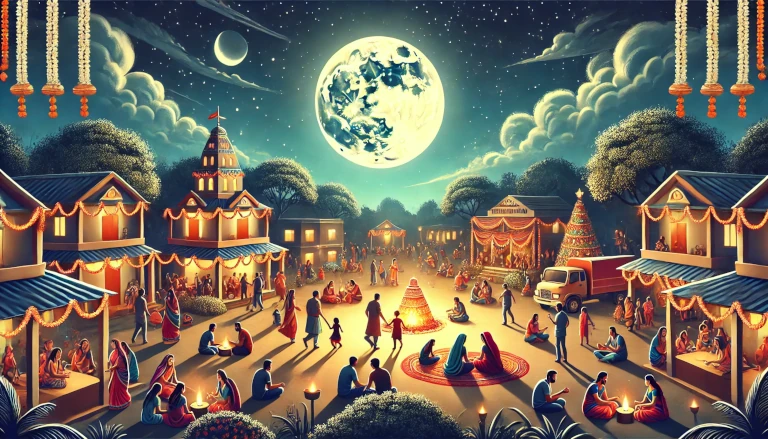Kojagiri Purnima, also known as Sharad Purnima or Kaumudi Purnima, is a significant Hindu festival celebrated on the full moon night of the Hindu month of Ashwin. This auspicious day marks the end of the monsoon season and the beginning of the harvest season, celebrated with rituals, prayers, and traditional foods. Kojagiri Purnima is a night dedicated to the Goddess Lakshmi, the deity of wealth and prosperity, and is believed to bring blessings and good fortune to those who stay awake all night.
In this blog post, we’ll explore the significance of Kojagiri Purnima, its unique traditions, and how it is celebrated across India. Whether you are familiar with the festival or are learning about it for the first time, this guide will help you understand the essence of Kojagiri Purnima.
The Significance of Kojagiri Purnima 🌕
Kojagiri Purnima holds cultural, spiritual, and agricultural importance. It is believed that on this full moon night, Goddess Lakshmi descends to earth and blesses those who are awake, bringing wealth and prosperity. Here are some key aspects of its significance:
1. Welcoming Goddess Lakshmi 🕯️
Kojagiri Purnima is primarily dedicated to Goddess Lakshmi. Devotees stay awake, engage in prayers, and sing hymns to invoke her blessings. It is believed that those who remain awake on this night will be blessed with prosperity and good fortune.
- Example: Families decorate their homes with oil lamps and create rangolis to welcome Goddess Lakshmi and seek her blessings.
2. Celebrating the Harvest Season 🌾
Kojagiri Purnima marks the end of the monsoon and the beginning of the harvest season. This is a time to express gratitude for the bountiful crops and to celebrate nature’s abundance.
- Tip: Many people prepare special dishes using fresh seasonal ingredients, symbolizing the start of the harvest.
3. The Divine Power of the Moonlight 🌙
According to Hindu beliefs, the moon on Kojagiri Purnima night is said to have special powers. It is believed that the moonlight has healing properties and enhances the potency of foods left under its glow.
- Example: People place milk-based dishes outside under the moonlight, believing that the moon’s rays bless the food with health benefits.
Traditional Celebrations and Rituals of Kojagiri Purnima 🎉
Kojagiri Purnima is celebrated with various customs and rituals, each reflecting the unique cultural heritage of the region. Here are some popular traditions observed during this festival:
1. Staying Awake All Night 🌙
One of the most distinctive rituals of Kojagiri Purnima is staying awake throughout the night. Devotees sing devotional songs, recite prayers, and meditate to keep themselves engaged.
2. Drinking Masala Doodh (Spiced Milk) 🥛
A special drink called Masala Doodh, made with milk, saffron, nuts, and spices, is prepared on this night. The milk is kept under the moonlight and then consumed by family members.
- Tip: Drinking Masala Doodh is believed to strengthen the immune system and bring good health.
3. Making Offerings to the Moon 🌕
People offer milk, sweets, and rice flakes to the moon, symbolizing gratitude for blessings and a good harvest. These offerings are later shared among family members and friends.
4. Playing Games and Social Gatherings 🎲
In many regions, families and friends gather to play traditional games and enjoy cultural performances, making the night lively and festive.
Kojagiri Purnima Across India 🌍
Though Kojagiri Purnima is celebrated throughout India, the customs may vary depending on the region. Here are some regional variations:
1. Maharashtra 🪔
In Maharashtra, Kojagiri Purnima is celebrated with great enthusiasm. People place milk and sweets outside under the moonlight, and the whole community often gathers to perform Lakshmi Puja.
2. West Bengal 🌸
In West Bengal, the festival is known as Sharad Purnima and is associated with Lord Krishna and Radha’s Raas Leela. Devotees observe fasts and worship Lord Krishna, celebrating his love and divine presence.
3. Odisha and Eastern India 🎋
In Odisha, people celebrate this day as Kumar Purnima, where young girls pray for a suitable life partner and worship Lord Kartikeya. Traditional songs and dances are a big part of the celebrations.
Practical Ways to Celebrate Kojagiri Purnima at Home 🏠
Here are some simple ways to celebrate Kojagiri Purnima at home:
- Set Up a Small Puja Altar 🪔: Place an idol or picture of Goddess Lakshmi and decorate it with flowers, oil lamps, and incense sticks.
- Prepare Masala Doodh 🥛: Make Masala Doodh with milk, cardamom, saffron, and nuts. Leave it outside under the moonlight before enjoying it with family.
- Spend Time in Moonlight 🌙: If possible, spend time outdoors to soak in the moonlight and meditate on the beauty and tranquility of the night.
- Exchange Sweets and Good Wishes 🎁: Share sweets with neighbors and friends, and extend blessings for prosperity and happiness.
Embracing the Spirit of Kojagiri Purnima 🌕🎉
Kojagiri Purnima is a night of devotion, celebration, and community bonding. By participating in the rituals, we connect with our cultural roots and express gratitude for nature’s bounty. Whether you observe Kojagiri Purnima with grand festivities or a quiet night of reflection, this festival reminds us to appreciate the abundance in our lives and to seek blessings for prosperity and well-being.
Discover more from Green Ecosystem - Renewable Energy, Agriculture, and Environmental Sustainability
Subscribe to get the latest posts sent to your email.


